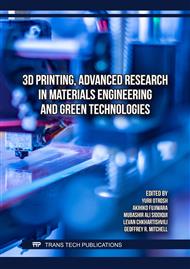p.3
p.9
p.19
p.27
p.35
p.45
p.53
p.63
p.75
A Study on the Influence of Metal Sheet Enclosure on Temperature Uniformity in FDM Printing Environments
Abstract:
For fused deposition modeling (FDM) 3D printing, maintaining consistent local ambient temperature is critical to prevent warping, poor layer adhesion, and dimensional errors. This study investigated the efficacy of a metal sheet enclosure in preserving thermal uniformity during FDM printing, addressing the limited information on metal enclosures' performance. Experiments were conducted using ABS filament on a Creality Ender 3 Pro, comparing an open-frame setup with a custom 500x600x620mm metal sheet enclosure. Results show the metal enclosure significantly enhanced thermal stability. The open-frame setup exhibited unstable temperatures, fluctuating from a peak of 58.0°C to 36°C, averaging 49.5°C. Conversely, the metal enclosure maintained a stable plateau between 65-67°C for most of the print, reaching a peak of 72.0°C and averaging 63.0°C. Qualitatively, open-frame prints displayed surface cracking and suboptimal layer adhesion, while enclosed prints showed markedly improved surface finish with no visible cracks and smoother layers. The metal enclosure acts as a thermal buffer, mitigating environmental changes and convective heat loss, thus improving print quality and reliability by ensuring thermal consistency in FDM 3D printing.
Info:
Periodical:
Pages:
35-42
Citation:
Online since:
October 2025
Price:
Сopyright:
© 2025 Trans Tech Publications Ltd. All Rights Reserved
Share:
Citation:


